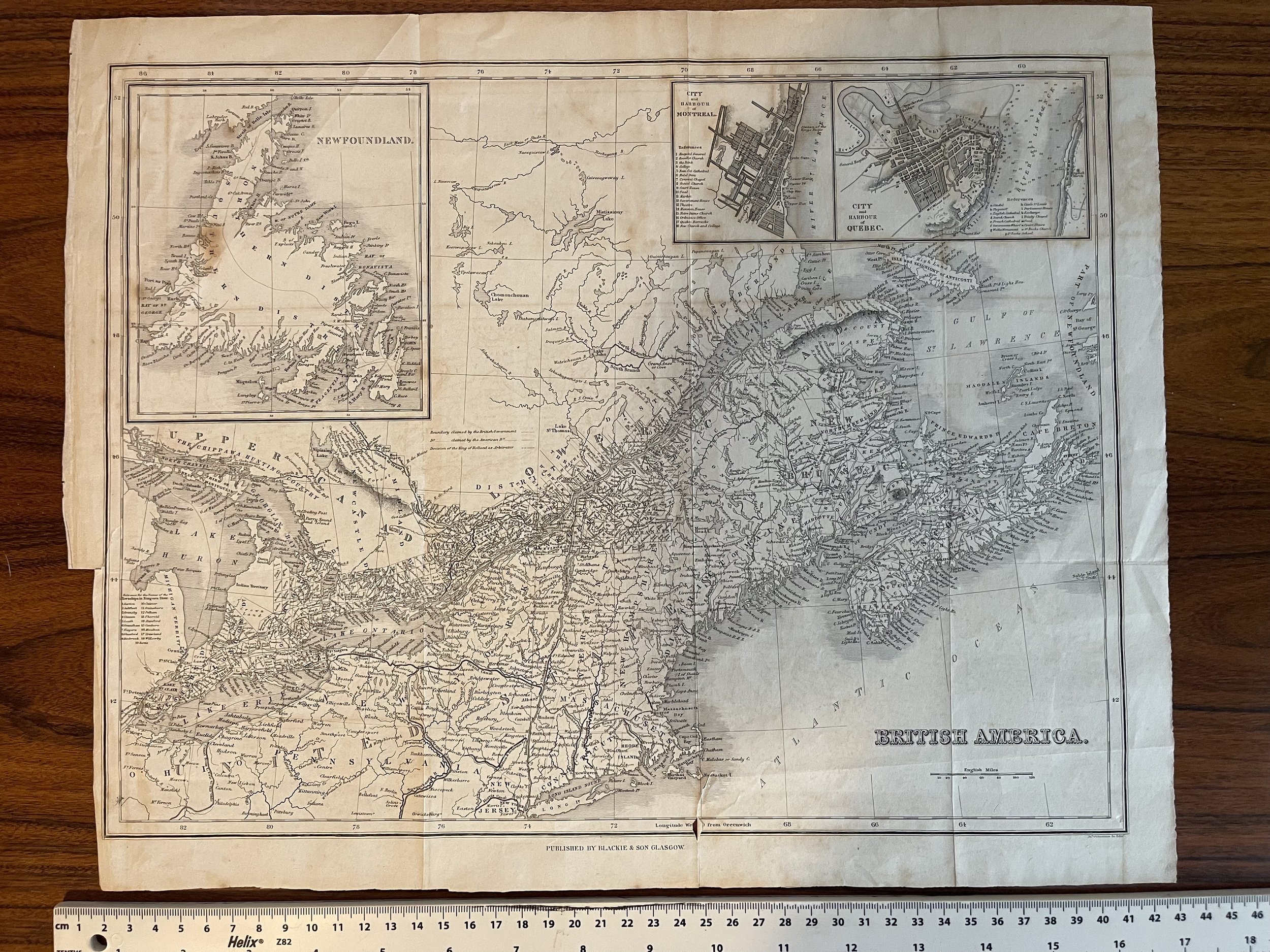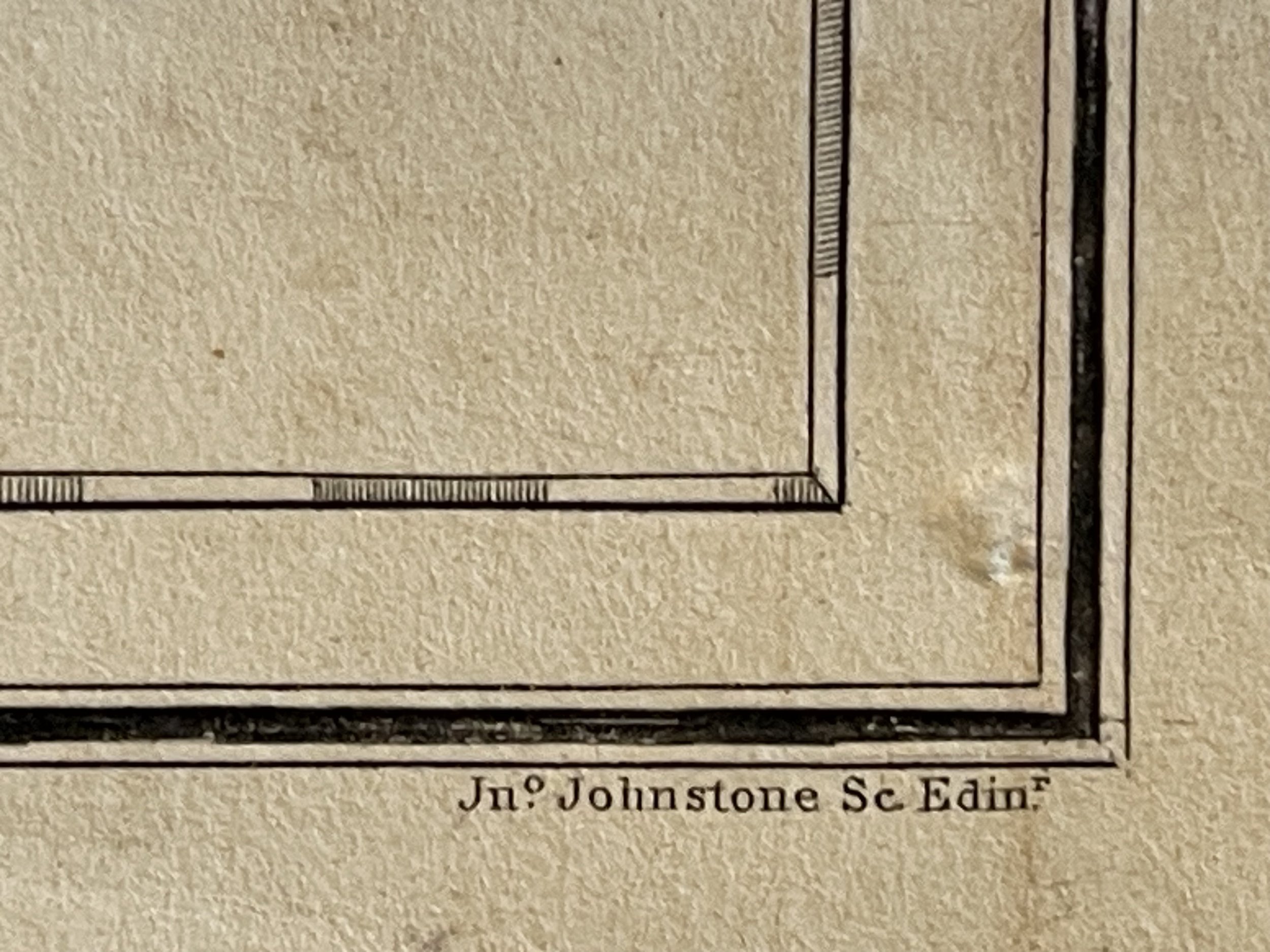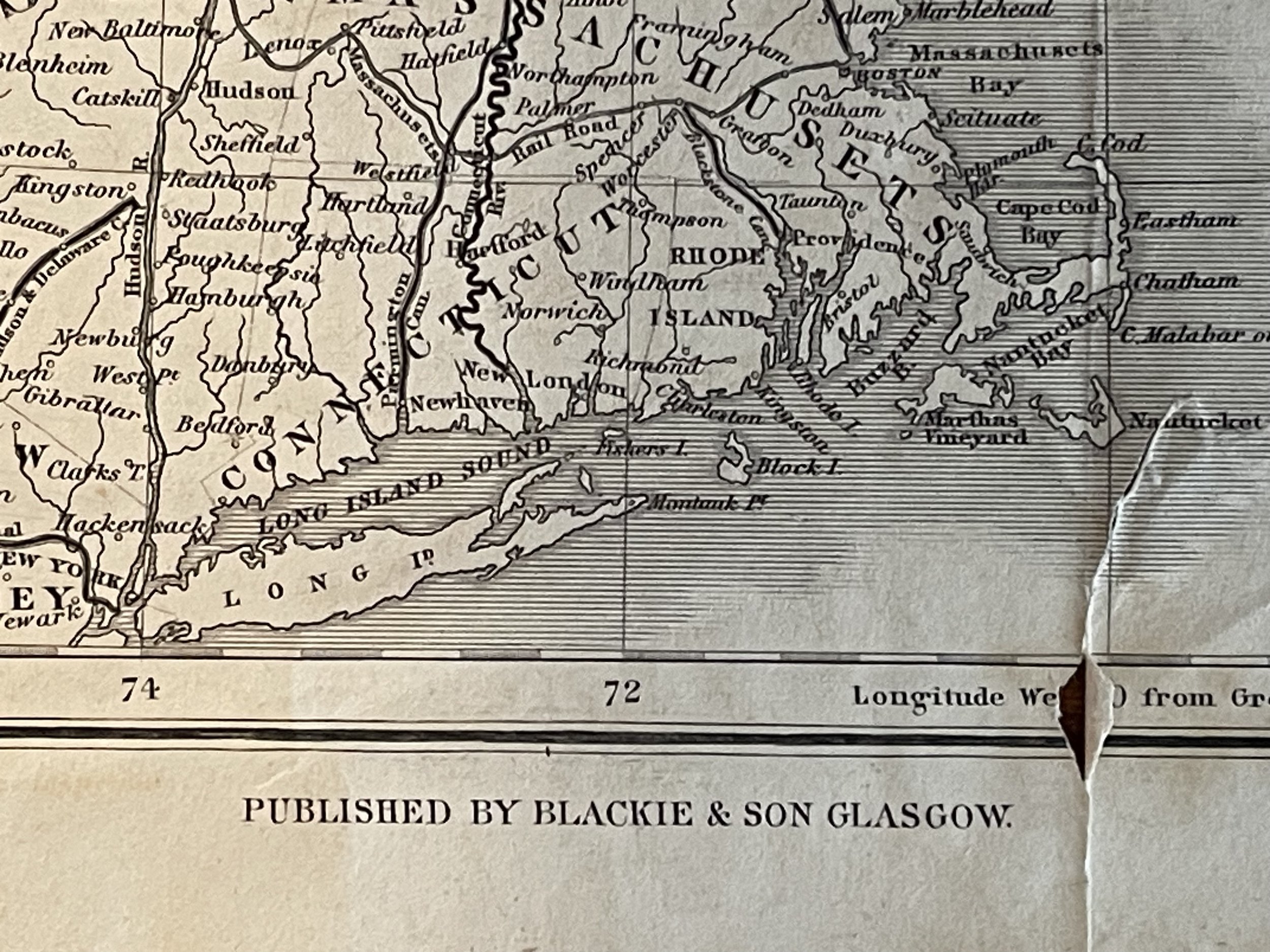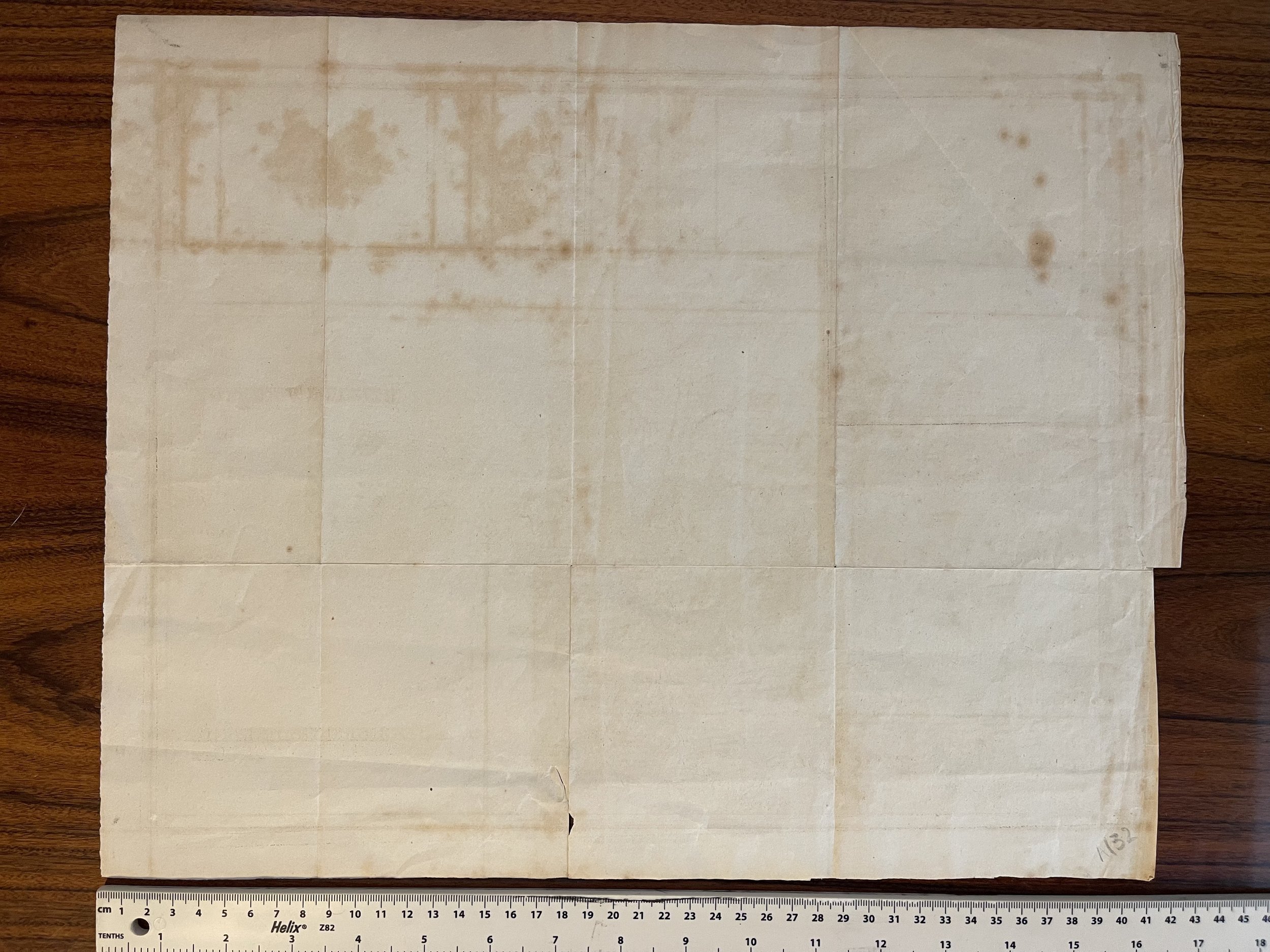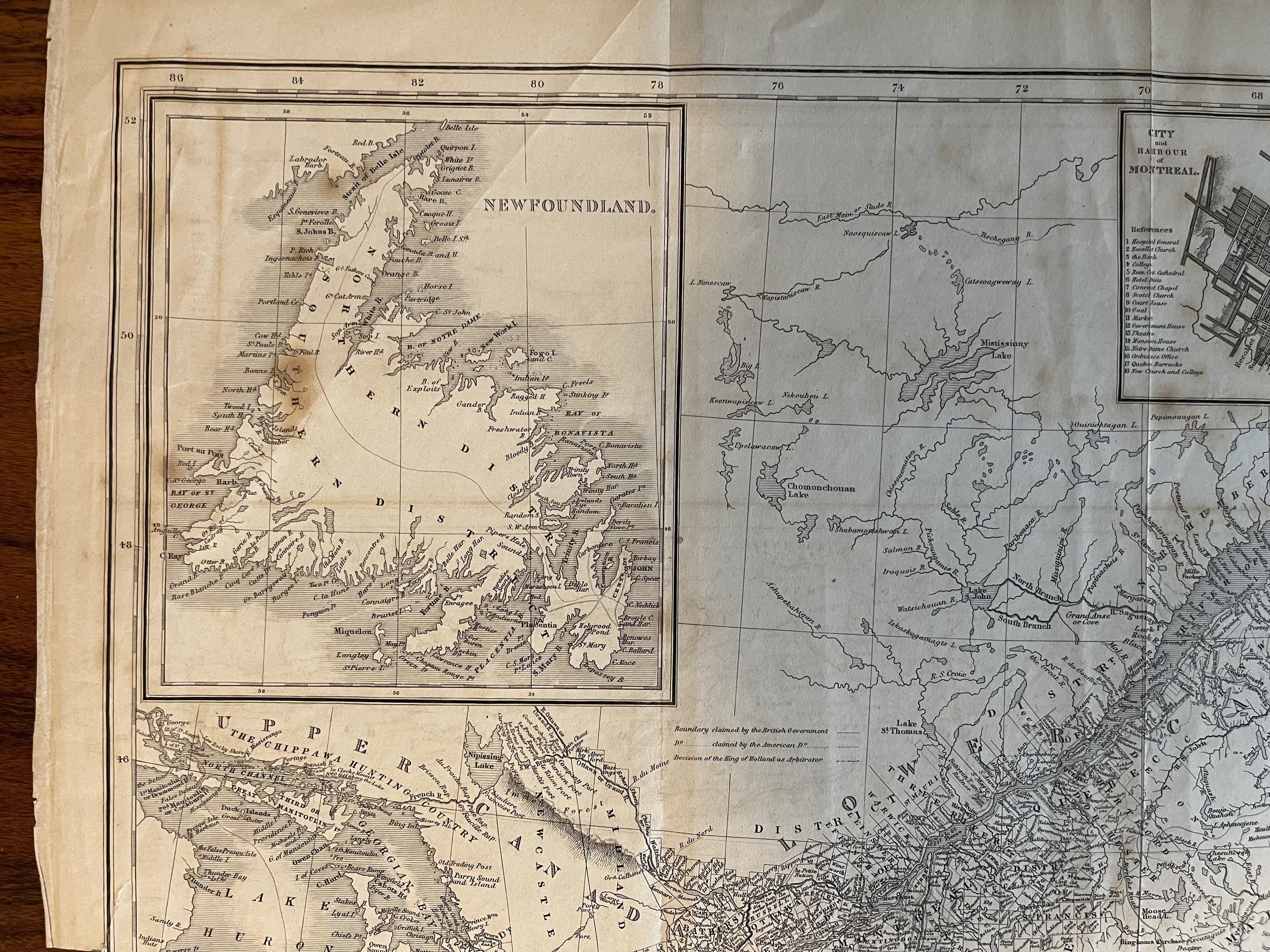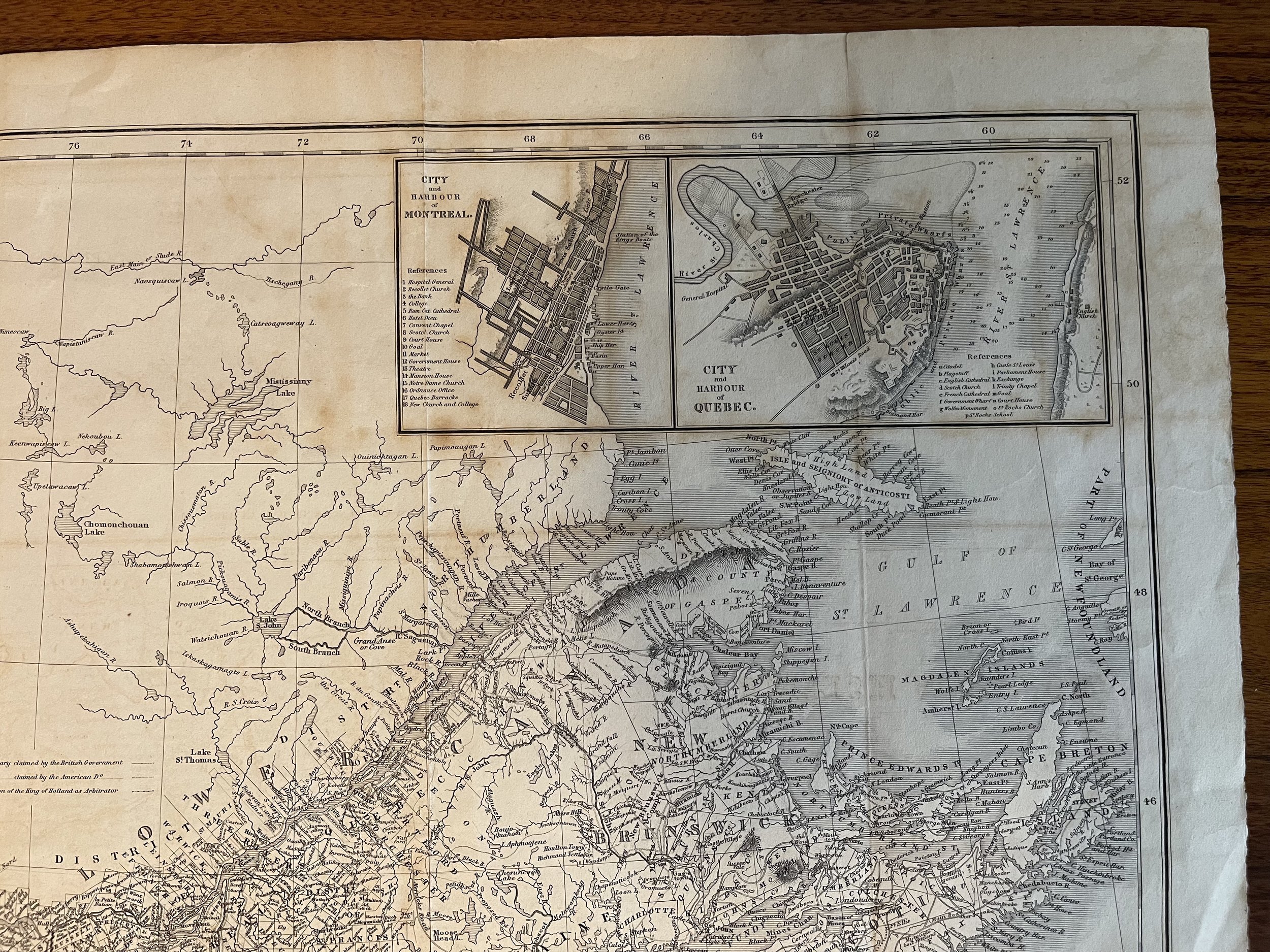British America - Blackie & Son - Circa 1860
British America - 1860 Approx.
Blackie & Son was a publishing house in Glasgow, Scotland, and London, England, from 1809 to 1991
The firm was founded as a bookseller in 1809 by John Blackie (1782–1874) as a partnership with two others and was known as 'Blackie, Fullarton and Company'. It began printing in 1819, using the skill and equipment of Edward Khull. It moved to Glasgow around 1830 and had premises at 8 Clyde Street facing the River Clyde. Following the retirement of Fullarton the company was renamed 'Blackie and Son' in 1831, remaining in the Clyde Street property, and becoming a public limited company in 1890. Later on, the business moved its Glasgow office to 17 Stanhope Street, and also opened offices at 5 South College Street in Edinburgh and 16/18 William IV Street, Charing Cross, London. The company also opened offices in Canada and India. It ceased publishing in 1991.
Blackie and Son initially published books sold by subscription, including religious texts and reference books. Later the firm published single volumes, particularly school-level educational texts and children's books, taking advantage of compulsory education from 1870. It also published "finely printed 'toy' and 'reward' books" (the latter being "intended for presentation as prizes to pupils in day and Sunday schools").
In 1893 Blackie and Son appointed Talwin Morris as the firm's art director and book designer. During his tenure, until his death in 1911, Morris was "responsible for the first integrated and visually homogenised approach to the mass production of easily affordable books" for any British publisher. He also designed books for Gresham Publishing, a subsidiary of Blackie and Son.
Blackie published G. A. Henty's historical adventure books for boys (e.g. With Kitchener in the Soudan and With Lee in Virginia) which were very popular in the British Empire in the later 19th century; Henty wrote 122 books including adult novels.
From 1920, under the guidance of the Cambridge-trained engineer and mathematician, Frederick Bisacre, who became a Blackie and Son partner and subsequently its chairman, the firm began to publish a scientific list "at the cutting edge of research" and which would become the "strongest list in the area" from any British commercial publisher.
Blackie published the many Flower Fairy books of Cicely Mary Barker beginning in 1923. From the 1950s onwards it published The Kennett Library, a graded series of classics retold for schools including: Kidnapped, Little Women, Westward Ho! The Black Arrow, Wuthering Heights and Ben-Hur. From 1960 to 1991, Blackie published over 130 "Topsy and Tim" titles by Jean and Gareth Adamson.
In 1902, Walter Blackie commissioned Hill House on a plot in Helensburgh to the West of Glasgow. The architect was Charles Rennie Mackintosh, a friend of Talwin Morris. The house is regarded as one of Mackintosh's finest works.
British America - 1860 Approx.
Blackie & Son was a publishing house in Glasgow, Scotland, and London, England, from 1809 to 1991
The firm was founded as a bookseller in 1809 by John Blackie (1782–1874) as a partnership with two others and was known as 'Blackie, Fullarton and Company'. It began printing in 1819, using the skill and equipment of Edward Khull. It moved to Glasgow around 1830 and had premises at 8 Clyde Street facing the River Clyde. Following the retirement of Fullarton the company was renamed 'Blackie and Son' in 1831, remaining in the Clyde Street property, and becoming a public limited company in 1890. Later on, the business moved its Glasgow office to 17 Stanhope Street, and also opened offices at 5 South College Street in Edinburgh and 16/18 William IV Street, Charing Cross, London. The company also opened offices in Canada and India. It ceased publishing in 1991.
Blackie and Son initially published books sold by subscription, including religious texts and reference books. Later the firm published single volumes, particularly school-level educational texts and children's books, taking advantage of compulsory education from 1870. It also published "finely printed 'toy' and 'reward' books" (the latter being "intended for presentation as prizes to pupils in day and Sunday schools").
In 1893 Blackie and Son appointed Talwin Morris as the firm's art director and book designer. During his tenure, until his death in 1911, Morris was "responsible for the first integrated and visually homogenised approach to the mass production of easily affordable books" for any British publisher. He also designed books for Gresham Publishing, a subsidiary of Blackie and Son.
Blackie published G. A. Henty's historical adventure books for boys (e.g. With Kitchener in the Soudan and With Lee in Virginia) which were very popular in the British Empire in the later 19th century; Henty wrote 122 books including adult novels.
From 1920, under the guidance of the Cambridge-trained engineer and mathematician, Frederick Bisacre, who became a Blackie and Son partner and subsequently its chairman, the firm began to publish a scientific list "at the cutting edge of research" and which would become the "strongest list in the area" from any British commercial publisher.
Blackie published the many Flower Fairy books of Cicely Mary Barker beginning in 1923. From the 1950s onwards it published The Kennett Library, a graded series of classics retold for schools including: Kidnapped, Little Women, Westward Ho! The Black Arrow, Wuthering Heights and Ben-Hur. From 1960 to 1991, Blackie published over 130 "Topsy and Tim" titles by Jean and Gareth Adamson.
In 1902, Walter Blackie commissioned Hill House on a plot in Helensburgh to the West of Glasgow. The architect was Charles Rennie Mackintosh, a friend of Talwin Morris. The house is regarded as one of Mackintosh's finest works.
British America - 1860 Approx.
Blackie & Son was a publishing house in Glasgow, Scotland, and London, England, from 1809 to 1991
The firm was founded as a bookseller in 1809 by John Blackie (1782–1874) as a partnership with two others and was known as 'Blackie, Fullarton and Company'. It began printing in 1819, using the skill and equipment of Edward Khull. It moved to Glasgow around 1830 and had premises at 8 Clyde Street facing the River Clyde. Following the retirement of Fullarton the company was renamed 'Blackie and Son' in 1831, remaining in the Clyde Street property, and becoming a public limited company in 1890. Later on, the business moved its Glasgow office to 17 Stanhope Street, and also opened offices at 5 South College Street in Edinburgh and 16/18 William IV Street, Charing Cross, London. The company also opened offices in Canada and India. It ceased publishing in 1991.
Blackie and Son initially published books sold by subscription, including religious texts and reference books. Later the firm published single volumes, particularly school-level educational texts and children's books, taking advantage of compulsory education from 1870. It also published "finely printed 'toy' and 'reward' books" (the latter being "intended for presentation as prizes to pupils in day and Sunday schools").
In 1893 Blackie and Son appointed Talwin Morris as the firm's art director and book designer. During his tenure, until his death in 1911, Morris was "responsible for the first integrated and visually homogenised approach to the mass production of easily affordable books" for any British publisher. He also designed books for Gresham Publishing, a subsidiary of Blackie and Son.
Blackie published G. A. Henty's historical adventure books for boys (e.g. With Kitchener in the Soudan and With Lee in Virginia) which were very popular in the British Empire in the later 19th century; Henty wrote 122 books including adult novels.
From 1920, under the guidance of the Cambridge-trained engineer and mathematician, Frederick Bisacre, who became a Blackie and Son partner and subsequently its chairman, the firm began to publish a scientific list "at the cutting edge of research" and which would become the "strongest list in the area" from any British commercial publisher.
Blackie published the many Flower Fairy books of Cicely Mary Barker beginning in 1923. From the 1950s onwards it published The Kennett Library, a graded series of classics retold for schools including: Kidnapped, Little Women, Westward Ho! The Black Arrow, Wuthering Heights and Ben-Hur. From 1960 to 1991, Blackie published over 130 "Topsy and Tim" titles by Jean and Gareth Adamson.
In 1902, Walter Blackie commissioned Hill House on a plot in Helensburgh to the West of Glasgow. The architect was Charles Rennie Mackintosh, a friend of Talwin Morris. The house is regarded as one of Mackintosh's finest works.
Code : A132
Cartographer : Cartographer / Engraver / Publisher: Blackie & Son - Glasgow
Date : Publication Place / Date - Circa 1860
Size : Sheet size: Image Size: 43 by 36 cm.
Availability : Available
Type - Genuine - Antique
Grading B-
Where Applicable - Folds as issued. Light box photo shows the folio leaf centre margin hinge ‘glue’, this is not visible otherwise.
Tracked postage, in casement. Please contact me for postal quotation outside of the UK.
